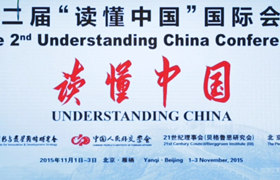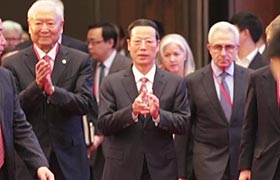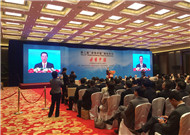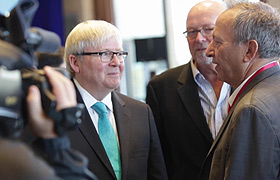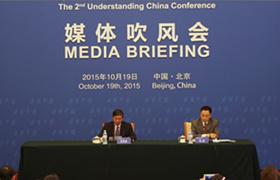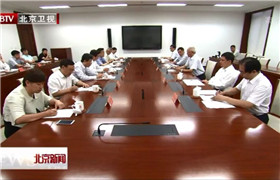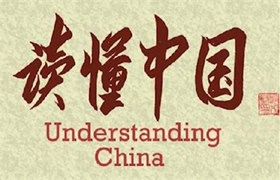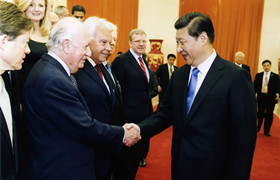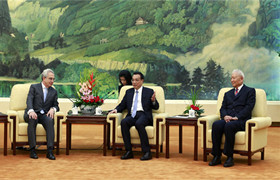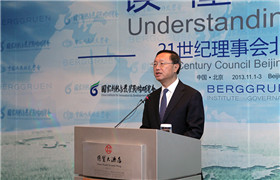- HOME--> Research
-
Strategic Vision on "the Rise of the Western Region & Collaborated Development of the Eastern and Western Regions"
Source:CIIDS
(This is an excerpt of the internal report on the themed research Strategy for the Rise of the Western Region presided over by Chairman Zheng Bijian, compiled on May 23, 2013) The subject was initiated in August 2012, and following its inception, Chairman Zheng Bijian, aged 80, led a survey team for on-site investigations in four provinces (Yunnan, Guangxi, Xinjiang and Sichuan), where team members discussed and exchanged ideas with the local government officials and the experts and scholars from the local development and reform commissions, academies of social sciences, party schools and universities.
I. Background information on the establishment of the strategy
(i) As early as in 1988, Deng Xiaoping gave birth to the strategic thinking of "two overall situations," where "coastal areas are in a position to speed up the opening up...which helps to better develop the inland areas. This is a decisive factor for the overall situation, and the inland areas must take the overall situation into consideration. In turn, once the development in coastal areas has reached a certain level, these areas will be required to spare more effort to help the inland areas, which is also an overall situation, to which the coastal areas should subject." When will the issue be proposed and addressed, and on what basis? "It is envisaged that the timing for a proposal as well as solution will come by the end of the century upon China’s entry to a well-off society," stated Mr. Deng in his South Tour Speech 1992.
(ii) Two decades have passed since the Speech, and China has undergone profound changes in its development. The development plan for central and western China beginning at the end of last century was a prelude for "the rise of the west region." Outpacing the eastern region by growth rate, though, the west region still faces multiple challenges of uneven development, which seems to be the largest and most pressing challenge.
(iii) An overview of the domestic situation tells that it is time to reverse this predicament radically in our journey towards a moderately well-off society. Our suggestion is that, while the eastern part of China is advancing to new heights, the government should blueprint development plans for the western part, and make more efforts to step up the “rise of the western region” in order to achieve a balance between the eastern and the western regions. In this way, we can better attain stability and border consolidation through reform and opening up, wipe out the deep-rooted poverty in the west, and achieve ethnic harmony and common development in the northwest part, especially in Xijiang.
In respect of the overall international situation, given the in-depth development of economic globalization today, China's western development plan cannot be accomplished without the opening up of the localities. Western China has a complicated periphery context, but the multi-faceted favorable factors still ensure us of an outstanding opportunity to seek extensive opening up westwards.
The domestic and international situations should be coordinated, as we can expect the final battle of the rise of western China in the coming eight to ten years, namely from the convening of the 18th CPC National Congress, especially the Third Plenary Session of the 18th CPC Central Committee, to 2020 or 2021.
(iv) The preferable strategy for the rise seems to be border-inwards. In current conditions, Xinjiang in the northwest and Yunnan and Guangxi in the southwest stand at the forefront of the development and opening up, faced with all kinds of urgent, outstanding problems, where pilot work can be done.
In Northwest China (exclusively Xinjiang hereinafter), despite the presence of terrorism, instability and ethnic conflicts, we have, generally speaking, made great social and economic achievements, laying an important foundation for further development. Externally, despite the presence of the "three evil forces" and the intervention of other powers in neighboring Central Asia, the region that is rich in resources, boosts fast-growing market potentials and has counter-terrorism cooperation with China provides us with a good opportunity for cooperation and co-development.
Southwest China (mainly Yunnan and Guangxi, also Sichuan and Chongqing as a joint strategic rear base. Tibet excluded for the time being) presents a different picture from that of Northwest China, as this area enjoys more favorable conditions for development. While external pressure is escalating, we in general enjoy great potentials of economic cooperation with Southeast Asia and South Asia the two regions with a large population and a vast market.
Therefore, it is absolutely necessary and feasible to carry on the strategy of “the rise of the western and collaborated development of the eastern and western regions” from now on, where the opportunities outweigh the challenges. Of course, given all the complexities in practice, we will emphasize differentiation from region to region regarding the speed and intensity of the opening-up rollout.
(v) From the level of development, it seems that we can measure whether a well-off society in an all-round way is completed across the western regions by the following five standards: First, the GDP proportion of the twelve western provinces and regions rises to one third of the national total over the current one quarter by 2020, coupled with a per capita GDP not less than the national average. Second, the key indicators of people's livelihood and social development approach that in the eastern region. Third, ethnic and religious tensions are mitigated, with the absolute majority of people living in harmony. Fourth, ecological deterioration has been fundamentally curbed. Fifth, the progress in house gradually facilitates the development of the surrounding countries and regions.
This requires us to 1) coordinate the domestic and international situations, and 2) coordinate border consolidation, development, reform and opening up.
This is definitely a major event. This cannot be done without large-scale and concerted efforts, without an emancipated mind, and without an enthusiastic spirit to revitalize the Chinese nation and develop the western China.
II. A brand-new layout under the strategy to take shape in a decade
(i) The relevant state leadership system should be restructured to facilitate the formation of the new layout subject to unified command.
As the development and opening up of western China involves a number of neighboring countries, the situations facing us are quite complicated and changeable. In this sense, the western development and opening up shall become a national strategy and require more effort that that given to the eastern part (the Pearl River Delta, the Yangtze River Delta and the circum-Bohai Area). To this end, the leadership system and coordination mechanism of the western development and opening up shall be restructured.
(ii) An opening-up belt will be built across the western region, with special zones set up and port systems improved, creating a new layout featuring a "three-tier strategic echelon."
In view of the new realities in and around the western regions, we may expect an enhanced role of southwest and northwest China in its opening up, coupled with reinforced development and opening up in eastern China on an ongoing basis while the primary focus shifts westwards, creating an opening-up belt across the western region to maximize their special location-based edges. In particular, a highly regional frontier for opening up will be constructed via the Shanghai Cooperation Organization and the China-ASEAN (10 + 1) FTA.
For example, the good practices in eastern China provide a reference, encouraging us to set up several special economic zones with greater openness in the northwest and southwest, such as Horgos, Kashgar and Yining in Xinjiang, Ruili, Tengchong and Xishuangbanna in Yunnan, and Pingxiang and Beibu Gulf in Guangxi province, where pilot work can be done to handle special cases with special methods, making it a boost for common development of western China and the surrounding regions.
Besides, we can develop our border port systems, establishing a four-tier hierarchy at the provincial, city, county and township levels to provide the flow of people and goods with an easier entry and exit, while strengthening the management of cross-border personnel and materials. Greater decision-making power in the opening up policy should be conferred to Chongqing, Chengdu, Xi'an, Urumqi, Kunming and Nanning.
This will constitute a "three-tier strategic echelon" in practice. The first tier consists of dozens of small border cities as the strategic frontier for western China’s opening up. The second tier contains Urumqi, Kunming and Nanning, the three major sub-regional strategic bases. The third tier is an "iron triangle" covering Chengdu, Chongqing and Xi'an (eligible to become China's three major hubs throughout Eurasia) to support the strategy. The three-tier echelon layout will, together with the regional strategy for central and eastern China, form a new pattern of development nationwide in line with the requirements for the Two Centenary Goals.
(iii) Investment in western China should be doubled to accelerate urbanization and industrialization, and to build a unique industrial chain and a financial highland in this region, thus forming a new layout combining border consolidation and development.
In the coming period, the western region will remain at the stage of investment-led growth. To achieve the 2020 goal and increase the proportion of GDP of western region to one-third of the national total, China needs to further increase investment, preferential tax and resources compensation efforts to keep the western region above the national average in economic growth.
Established competitive scale industries (such as electronic information, aerospace, R&D of endemic biological resources and featured agriculture, etc.) will be the forefront to build and improve the unique industrial chain of western China throughout the industrialization process. Urbanization combined with industrialization with western characteristics should be accelerated. Border consolidation efforts and reform of administrative divisions will be put forward to build a number of new city clusters and belts.
A long-term perspective is necessary to create a financial highland. We can study the feasibility of establishing an international financial center in the western region, piloting RMB’s internationalization and financial opening up in Urumqi, Kunming and Nanning, and setting up the China-Arab international settlement center in Yinchuan, thus facilitating international capital to flow in directly.
(iv) With a focus on the long-term stability and a protective screen for ecological security in western China, the new layout of the western water diversion project will be initiated.
The western region, being birthplace of the Yangtze and Yellow Rivers and other water systems, is a protective screen for China’s ecological security, yet the most vulnerable part of the national ecosystem. The water issue is crucial for the recovery and refinement of the ecological environment in the West (especially Northwest). Since the water diversion projects in the central and eastern regions are supposed to be completed by next year, we recommend starting research and demonstration on the western water diversion project as soon as possible to develop a workable plan.
Two plans have been developed for the western water diversion project, a small one and a big one. The roll-out should be sped up upon coordinated needs across the relevant provinces and in line with the relevant UN conventions.
(v) The construction of a major westward thoroughfare should be accelerated to form a new pattern for comprehensive interconnection with the surrounding countries. The network of northwest and southwest railway corridors will serve as the backbone, in conjunction with the northwest and southwest highway matrix, river shipping lines, oil and gas pipelines, power grids and communications network, to constitute the general network, which will greatly enhance the interaction with the surrounding countries regarding the flow of people, logistics, capital and information, and nurture a “point of convergence for interests” and a "community of interests". Internally, we can promptly launch high-speed rail construction along the Xi'an - Chengdu - Kunming l and the Kunming - Nanning - Guangzhou railway. Externally, we can speed up the construction of the China - Pakistan - Iran railway with Kashgar as a starting point, as well as of the Kunming - Ruili - Myanmar railway stretching to the Indian Ocean (where the Chongqing - Horgos - Central Asia - Europe railway has been put into operation).
(vi) We should seize the unprecedented opportunities in the rise of the western region and reorganize a powerful force of leaders. It is expected that once the new layout is in place, a large number of outstanding officials, professionals and young people will be inspired and attracted to embrace this vast arena to hone their will and display their talent.
Therefore, we can make the best of the new opportunities, casting a new layout of qualified personnel guided by new ideas and new approaches.
For example, a variety of outstanding leading cadres in inland areas can be mobilized to serve at provincial, prefectural, and county levels in western minority and border regions or areas plagued by poor conditions, preferably for a long term.
The majority of young people and specialized personnel in inland areas can be attracted to work and start their businesses in the west region. More preferential policies should be offered to encourage them to take root in the west.
Ethnic minority cadres in the western border regions can take office in the eastern coastal areas on an exchange basis, and their number shall be expanded.
There should be more substantial increase in the wage margin for cadres working in the western minority and border regions and areas plagued by poor conditions, in order to enhance the enthusiasm and stability of the local leadership.
In short, we should refer to the practice of handling special cases with special methods in special economic zones of the eastern region, not only in economic development issues but also in leadership building.
(vii) The significant new opportunities for the rise of the western region should be utilized to develop an overall plan for ethnic, religious and demographic issues, with the relevant policies restructured and readjusted to fulfill the new layout.
The rise of the West requires us to deal with complex ethnic, religious and demographic problems, whilst the opportunities it contains make it possible for us to solve the three problems. We should seize the important brand-new momentum for overall planning, reform and restructuring of the corresponding policies, and we will open up a new chapter in the western region regarding the above three aspects.
(viii) More efforts should be made in anti-terrorism to safeguard the stability in the western region, with institutional innovation in the Xinjiang Production and Construction Corps.
A major concern in the northwest is the relations between ethnic groups in Xinjiang, and we should be psychologically prepared for the complexity and persistence of this long-term problem, being committed to economic development and people's livelihood while strengthening anti-terrorism and stability maintenance.
The Xinjiang Production and Construction Corps plays a vital role in the border consolidation and development for the long-term stability in Xinjiang. The Corps, however, is in urgent need of institutional innovation for self-enhancement.
III. Welcome the changes once in a millennium
The outline and formation of the layout for "the Rise of the Western Region & Collaborated Development of the Eastern and Western Regions" will bring unprecedented changes once in a millennium in the Chinese history.
As we envisage the development prospect, we know the significance of the rise of western China towards relatively even development between the eastern and western regions with extended international cooperation northwestwards and southwestwards to seek peace and common development: it is essential for the goal of the CPC to fully complete the building of a well-off society by the centennial jubilee of its birth, and a prerequisite for the Chinese dream to come true, getting over the middle-income trap and heading for an established modern socialist country that is prosperous, democratic, civilized and harmonious.
History will witness the transformation once in a millennium under the new collective leadership of the Communist Party of China, with Xi Jinping as General Secretary.
-
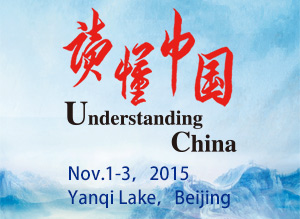
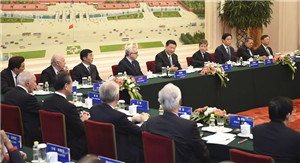
The 2nd "Understanding China" ConferenceOn November 1~3, 2015, the 2nd “Understanding China” Conference was held in Beijing Yanqi Lake International Conference Center. Zhang Gaoli, Vice Premier of the State Council, attended the opening ceremony.
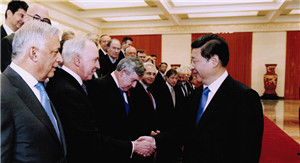
The 1st "Understanding China" ConferenceOn November 1~3, 2013, the 1st “Understanding China” Conference was held in Beijing, which was cosponsored by China Institute for Innovation & Development Strategy (CIIDS), Chinese People’s Institute of Foreign Affairs (CPIFA), and Berggruen Institute on Governance.
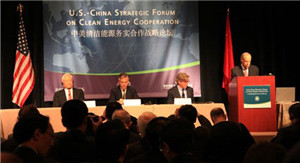
The 2nd U.S.-China Strategic Forum on Clean Energy CooperationWith the “Prospects for U.S.-China strategic cooperation in next decade” as its theme, the forum dwells on the implications of U.S.-China cooperation from the strategic perspective of coping with global challenges and maintaining world peace.
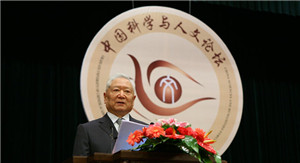
The China Sciences and Humanities ForumCo-initiated in April 2003 by renowned Chinese scientist Mr. Lu Yongxiang and influential political strategist Zhen Bijian, China Sciences and Humanities Forum was jointly hosted by Graduate University of Chinese Academy of Sciences (GUCAS) and the Higher Education Press.

